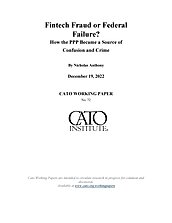The Paycheck Protection Program (PPP) has been plagued with issues since its inception. Yet the issues themselves proved to be far deeper than headlines of fraud and misused funds have suggested. Although PPP fraud should be condemned, the fraud itself was a symptom of a much more fundamental problem: namely, a failure of federal oversight for the government program.
A Brief PPP Primer
The PPP was established in April 2020 by the Coronavirus Aid, Relief, and Economic Security Act (CARES Act). In an effort to protect businesses and thereby “protect paychecks,” the PPP offered lowinterest loans to small businesses with the promise of forgiveness so long as the funds were used for qualifying business expenses and certain conditions were maintained. For example, qualifying business expenses included payroll, benefits, mortgage interest, rent, and utilities. In addition to spending the funds on specific resources, businesses were also required to maintain both staff and salary levels. To the extent these requirements could not be met, loans would need to be paid off with a 1 percent interest rate. However, loan payments could also be deferred, and, in all cases, there were no fees charged for the application process.
Lenders also stood to benefit from the PPP. The Small Business Administration (SBA) was the agency supervising the PPP, but the loans themselves were provided by private-sector lenders. To encourage lending, however, the SBA backed 100 percent of the loans so that lenders would not have to worry about the borrower defaulting—a bid to quell uncertainty regarding the surrounding pandemic and to get funds into the hands of those most at risk. The SBA also tried to reduce costs for lenders by requiring minimal underwriting on all loans.

